Adapters for Upright Nikon Eclipse Microscopes
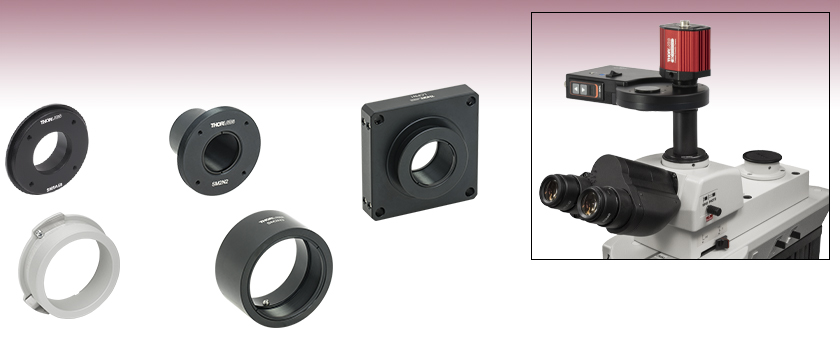
- Adapters for Epi-Illumination, Lamphouse, Camera, Trinocular, Eyepiece, and Condenser Ports
- Modify Upright Nikon Eclipse Microscopes Using Thorlabs' Optomechanical Components
SM1A58
Camera Port
Adapter
Application Idea
SM1A58 Camera Port Adapter Used to Mount an FW102C Motorized Filter Wheel and a Thorlabs’ Scientific Camera
SM2N2
Eyepiece
Adapter
LED4A5
Epi-Illumination Module
Bayonet Mount Adapter
LCPN1
Condenser Port Adapter
SM2N3
Lamphouse Port Adapter

Please Wait
Click on Each Port to View Available Adapters
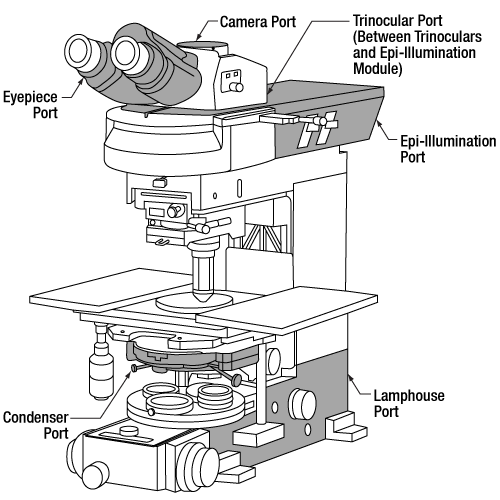
Figure 1.1 Nikon Eclipse FN1 Microscope
Features
- Extends Versatility of Thorlabs' Construction Systems to Upright Nikon Eclipse Microscopes
- Provides Compatibility with SM1 (1.035"-40) Lens Tubes, SM30 (M30.5 x 0.5) Lens Tubes, SM2 (2.035"-40) Lens Tubes, and 30 mm and 60 mm Cage Systems
- Contact Tech Support About Custom Adapters, Including for Other Microscopes
Illumination Adapters
Thorlabs offers adapters to modify the epi-illumination pathway to accept SM threading or a cage system. Adapters with a male Nikon bayonet mount adapt LED light sources and other collimated illumination sources.
The SM2N3 adapter is designed for a collimated illumination source to mount onto the lamphouse port.
Camera Port Adapter
The SM1A58 adapter is designed to allow components with SM1 threading, SM2 threading, or 30 mm cage system compatibility to be mounted to the camera port. These adapters are also compatible with Thorlabs' Cerna® microscopes and are ideal for inserting custom optics, as well as our scientific CMOS cameras, into brightfield and fluorescence microscope systems.
Camera Tube Adapter
The LCPN6 adapter is designed to allow Nikon and Cerna camera tubes to be integrated into systems built from Thorlabs' optomechanics. The female D2N dovetail connects to the camera tube, which can then be incorporated into a custom microscope system using SM1 threading, a 30 mm cage system, or a 60 mm cage system.
Trinocular Port Adapters
Custom widefield viewing and image detection setups can be connected to the trinocular port using an LCPN2, LCPN4, WFA4111, or SM2A59 adapter. The LCPN3 adapter can be use to connect the trinocular port to Olympus trinoculars with a D5Y dovetail. See the Microscope Dovetails tab for details about Olympus' D5Y dovetail.
Eyepiece Adapter
The SM2N2 adapter replaces the lens element on an eyepiece of the Nikon microscope's trinoculars, allowing custom image detection or viewing setups to be attached to the microscope.
Condenser Adapter
The LCPN1 and LCPN5 adapters connect to the condenser holder, allowing the attachment of DIY setups that condition incoming light for trans-illumination.
Note: Thorlabs does not guarantee compatibility with other industry-standard microscopes not explicitly mentioned on this webpage.
| Adapters for Industry Standard Microscopes |
|---|
| Cerna DIY Series |
| Leica DMI |
| Nikon Eclipse Ti (Inverted) |
| Nikon Eclipse Ti2 (Inverted) |
| Upright Nikon Eclipse |
| Olympus BX and IX |
| Zeiss Axioskop and Examiner |
| Table 76C Thorlabs Dovetail Referencea | |||
|---|---|---|---|
| Type | Shape | Outer Dimension | Angle |
| 95 mm | Linear | 95 mm | 45° |
| D1N | Circular | Ø2.018" | 60° |
| D2Nb | Circular | Ø1.50" | 90° |
| D2NBb | Circular | Ø1.50" | 90° |
| D3N | Circular | Ø45 mm | 70° |
| D5N | Circular | Ø1.58" | 90° |
| D6N | Circular | Ø1.90" | 90° |
| D7N | Circular | Ø2.05" | 90° |
| D8N | Circular | Ø40 mm | 90° |
| D9N | Circular | Ø50 mm | 90° |
| D10N | Circular | Ø52 mm | 90° |
| D1T | Circular | Ø1.50" | 60° |
| D3T | Circular | Ø1.65" | 90° |
| D4T | Circular | Ø1.20" | 90° |
| D1Y | Circular | Ø107 mm | 60° |
| D2Y | Circular | Ø2.32" | 50° |
| D3Y | Circular | Ø1.75" | 90° |
| D4Y | Circular | Ø56 mm | 60° |
| D5Y | Circular | Ø46 mm | 60° |
| D6Y | Circular | Ø41.9 mm | 45° |
| D1Z | Circular | Ø54 mm | 60° |
| D2Z | Circular | Ø57 mm | 60° |
| D3Z | Circular | Ø54 mm | 45° |
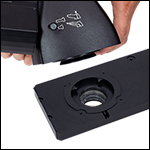
Click to Enlarge
Figure 76B This photo shows the male D1N dovetail on the trinoculars next to the female D1N dovetail on the epi-illumination arm.
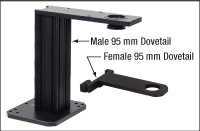
Click to Enlarge
Figure 76A This photo shows the male 95 mm dovetail on the microscope body and the female 95 mm dovetail on the CSA1002 Fixed Arm.
Introduction to Microscope Dovetails
Dovetails are used for mechanical mating and optical port alignment of microscope components. Components are connected by inserting one dovetail into another, then tightening one or more locking setscrews on the female dovetail. Dovetails come in two shapes: linear and circular. Linear dovetails allow the mating components to slide before being locked down, providing flexible positioning options while limiting unneeded degrees of freedom. Circular dovetails align optical ports on different components, maintaining a single optical axis with minimal user intervention.
Thorlabs manufactures many components which use dovetails to mate with our own components or those of other manufacturers. To make it easier to identify dovetail compatibility, we have developed a set of dovetail designations. The naming convention of these designations is used only by Thorlabs and not other microscope manufacturers. Table 76C lists all the dovetails Thorlabs makes, along with their key dimensions.
In the case of Thorlabs’ Cerna® microscopes, different dovetail types are used on different sections of the microscope to ensure that only compatible components can be mated. For example, our WFA2002 Epi-Illuminator Module has a male D1N dovetail that mates with the female D1N dovetail on the microscope body's epi-illumination arm, while the CSS2001 XY Microscopy Stage has a female D1Y dovetail that mates with the male D1Y dovetail on the CSA1051 Mounting Arm.
To learn which dovetail type(s) are on a particular component, consult its mechanical drawing, available by clicking on the red Docs icon (![]() ) below. For adapters with a female dovetail, the drawing also indicates the size of the hex key needed for the locking setscrew(s). It is important to note that mechanical compatibility does not ensure optical compatibility. Information on optical compatibility is available from Thorlabs' web presentations.
) below. For adapters with a female dovetail, the drawing also indicates the size of the hex key needed for the locking setscrew(s). It is important to note that mechanical compatibility does not ensure optical compatibility. Information on optical compatibility is available from Thorlabs' web presentations.
For customers interested in machining their own dovetails, Table 76C gives the outer diameter and angle (as defined by Figures 76D and 76E) of each Thorlabs dovetail designation. However, the dovetail's height must be determined by the user, and for circular dovetails, the user must also determine the inner diameter and bore diameter. These quantities can vary for dovetails of the same type. One can use the intended mating part to verify compatibility.
In order to reduce wear and simplify connections, dovetails are often machined with chamfers, recesses, and other mechanical features. Some examples of these variations are shown by Figures 76D and 76E.

Click to Enlarge
Figure 76D Two examples of how circular male dovetails can be manufactured.

Click to Enlarge
Figure 76E Two examples of how circular female dovetails can be manufactured.
| Posted Comments: | |
| No Comments Posted |

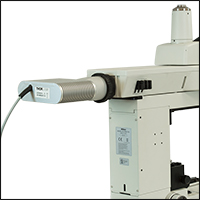
Click to Enlarge
Figure G1.2 LED4A5 Adapter Securing a 4-Channel LED Source to an
These adapters allow a collimated illumination source, such as Thorlabs' Solis® LEDs, to attach to the epi-illumination module of an upright Nikon Eclipse or Nikon Eclipse Ti microscope. Each adapter uses a male Nikon bayonet mount to connect to the module port. See Table G1.1 for adapter attachment compatibility.
Note: Thorlabs does not guarantee compatibility with other industry-standard microscopes not explicitly mentioned on this webpage.

| Item # | SM2N3 |
|---|---|
| Photo (Click to Enlarge) |
 |
| Dovetail |
Female D6Na |
| SM Threading | Internal SM2 (2.035"-40) |
| Microscope Compatibility | Upright Nikon Eclipse and Nikon Eclipse Ti and Ti2 Lamphouse Ports |
The SM2N3 adapter is designed to allow a collimated trans-illumination source, such as a Thorlabs Solis® LED with an SM2T2 adapter, to be attached to the lamphouse port of an Upright Nikon Eclipse, Nikon Eclipse Ti, or Nikon Eclipse Ti2 microscope. This adapter utilizes a female D6N dovetail to connect to the lamphouse port of the microscope; the dovetail is secured by the included setscrew (5/64" [2 mm] hex). See the Microscope Dovetails tab for details.
This adapter features internal SM2 (2.035"-40) threading for Ø2" lens tubes, and includes one SM2RR retaining ring to secure an optic against the internal lip of the adapter.
Note: Thorlabs does not guarantee compatibility with other industry-standard microscopes not explicitly mentioned on this webpage.

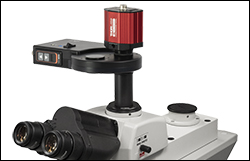
Click to Enlarge
Figure G3.1 An FW102C Filter Wheel and Scientific Camera attached to the Trinoculars of a Cerna Microscope. In addition to the SM1A58 adapter, an SM1L20 lens tube, SM1T10 lens tube coupler, and SM1A39 SM1 to C-Mount adapter are used to ensure parfocality of the camera.
The SM1A58 is designed so that custom-built optical systems or detectors based on Thorlabs' components may be attached to the camera port of Upright Nikon Eclipse Microscopes or Thorlabs' Cerna Microscopes. This adapter utilizes a male D2N dovetail to secure the adapter to the port.
The SM1A58 features internal SM1 (1.035"-40) threading for Ø1" Lens Tubes, external SM2 (2.035"-40) threading for Ø2" Lens Tubes, and 4-40 tapped holes on 30 mm centers for attaching cage system rods. Thorlabs' Scientific CMOS Cameras have options with industry standard C-mount threading that can be attached to the internal SM1 threads of the SM1A58 using the SM1A39 external C-Mount to external SM1 adapter, available separately. Our SM1 or SM2 lens tubes can be used to place the camera at the correct parfocal distance; the exact distance will depend upon the specific trinoculars or other camera ports present on your Nikon microscope.
For microscopes with trinoculars that create an inverted image, the camera sensor should be placed at a distance of 4.15" from the camera port; this can be achieved with a combination of the SM1A58 adapter, SM1T10 SM1 lens tube coupler, SM1L30 3" long SM1 lens tube, and SM1A9 C-Mount to SM1 adapter. For microscopes with trinoculars that create an erect image, an additional adapter available from Nikon is required to utilize the SM1A58 adapter. This space between the adapter and the camera can also be used for inserting custom optics and mechanical assemblies such as filter wheels (shown in Figure G3.1) or our two-camera mount. For more details on integrating the SM1A58 adapter with Thorlabs' Cerna Microscope components, please see our complete Cerna Widefield Viewing Modules webpage.
In addition, an SM1-threaded dust cover (Item # SM1CP2) is included to keep the port closed when not in use.
Note: Thorlabs does not guarantee compatibility with other industry-standard microscopes not explicitly mentioned on this webpage.

The LCPN6 adapter features a female D2N dovetail and internal SM1 (1.035"-40) threads for Ø1" Lens Tubes. A locking setscrew (5/64" [2 mm] hex) is provided to secure the position of the dovetail. Four through holes, each with a side-located locking setscrew (5/64" [2 mm] hex), can be used to attach Ø6 mm cage rods for 60 mm cage systems. The adapter also includes additional 4-40 tapped holes on 30 mm centers on the side opposite the dovetail for 30 mm cage systems.
The LCPN6 adapter is designed to allow Nikon and Cerna camera tubes to be integrated into user-built optomechanical assemblies from Thorlabs components. The adapter utilizes a female D2N dovetail to connect to the camera tube, which can then be incorporated into a custom microscope system using SM1 threading, a 30 mm cage system, or a 60 mm cage system. Compatible camera tubes include Nikon camera tubes with a male D2N dovetail and our TC1X camera tube. Additionally, the LCPN6 adapter can be used with other male D2N dovetail components, such as the SM1A58 camera port adapter (sold above), to provide a quick-release mechanism for SM1-to-SM1, SM1-to-30 mm cage, and SM1-to-60 mm cage coupling.
Note: Thorlabs does not guarantee compatibility with other industry-standard microscopes not explicitly mentioned on this webpage.

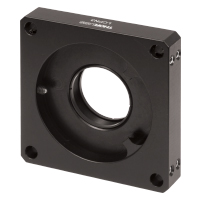
Click to Enlarge
Figure G5.2 D5Y Dovetail on the LCPN3 Adapter
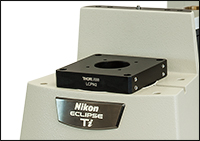
Click to Enlarge
Figure G5.1 The LCPN2 Adapter Attached to Exposed Trinocular Port
Our trinocular port adapters modify the trinocular port on an Upright Nikon Eclipse Microscope to accept custom widefield viewing setups or Olympus trinoculars. These adapters utilize a male D1N dovetail to connect to the trinocular port of the microscope, featured on the epi-illuminator module as well as on the microscope body itself. These adapters can only be attached by first removing the microscope's trinoculars, as shown in Figure G5.1.
The LCPN2 and LCPN3 adapters feature internal SM30 (M30.5 x 0.5) threading for Ø30 mm lens tubes; two SM30RR retaining rings are included to secure an optic inside the adapter. The LCPN4 adapter features SM2 (2.035"-40) threading for SM2 lens tubes and includes one SM2RR retaining ring. All three adapters have four through holes, each with side-located locking setscrews (5/64" [2 mm] hex) that can be used to attach Ø6 mm cage rods for 60 mm cage systems.
The LCPN2 and LCPN4 adapters are designed to be used with custom widefield viewing setups. The LCPN2 adapter also includes additional 4-40 tapped holes on 30 mm centers on the side opposite the dovetail for 30 mm cage systems. The LCPN3 adapter features a female D5Y dovetail to allow Olympus trinoculars with a male D5Y dovetail to be used with the Nikon Eclipse.
The WFA4111 and SM2A59 adapters are designed for custom widefield viewing setups. The WFA4111 adapter features internal M38 x 0.5 threading, which is compatible with our SM38RR retaining rings to secure an optic inside the adapter. The internal threading also directly accepts our TTL200 and ITL200 tube lenses, while external SM2 (2.035"-40) threading on the top of the adapter allows it to be integrated into SM2 lens tube systems. The SM2A59 adapter features internal SM2 (2.035"-40) threading, which can directly accept our SM2-threaded infinity-corrected tube lenses for widefield imaging. Alternatively, the internal SM2 threading can be used to integrate with our SM2 lens tube systems for the construction of custom image detection modules.
The dovetail designations are specific to Thorlabs products; see the Microscope Dovetails tab for details.
Note: Thorlabs does not guarantee compatibility with other industry-standard microscopes not explicitly mentioned on this webpage.

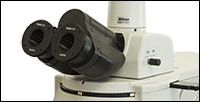
Click to Enlarge
Figure G6.1 Two SM2N2 adapters attached to the trinocular eyepieces.
The SM2N2 Eyepiece Adapter allows custom-built optical detection systems to attach to the eyepieces on the trinoculars of an upright Nikon Eclipse, Nikon Eclipse Ti, Nikon Eclipse Ti2, or Cerna microscope. This adapter replaces the lens element on the eyepiece that sets the image plane at the the back of the eyes (see Figure G6.1). Five alignment slots ensure the adapter fits snugly inside the eyepiece without rotation; because of the drop-in nature of the adapter, take care the attached system does not overbalance the 40 g eyepiece adapter when it is inside the trinoculars.
This adapter features internal SM1 (1.035"-40) threading for Ø1" lens tubes; two SM1RR retaining rings are included to secure an optic inside the adapter. The adapter also has external SM2 (2.035"-40) threading for Ø2" lens tubes. The face with the item # engraving has 4-40 tapped holes for 30 mm cage systems.
Note: Thorlabs does not guarantee compatibility with other industry-standard microscopes not explicitly mentioned on this webpage.

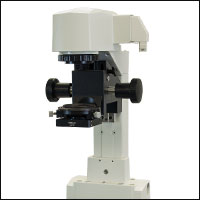
Click to Enlarge
Figure G7.1 LCPN1 Attached to Condenser Holder
Our Condenser Adapters utilize male D3N dovetails to connect custom condenser configurations to the condenser holder of an Upright Nikon Eclipse, Nikon Eclipse Ti and Ti2, or Cerna Microscope. See the Microscope Dovetails tab for details.
The LCPN1 adapter features internal SM30 (M30.5 x 0.5) threading for Ø30 mm lens tubes; two SM30RR retaining rings are included to secure an optic inside the adapter. The LCPN5 adapter features SM2 (2.035"-40) threading for SM2 lens tubes and includes one SM2RR retaining ring. Both adapters have four through holes with side-located locking setscrews (5/64" [2 mm] hex) that can be used to attach Ø6 mm cage rods for 60 mm cage systems. Additionally, the LCPN1 adapter features 4-40 tapped holes on 30 mm centers, located on the side opposite the dovetail, which can be used for 30 mm cage systems.
Note: Thorlabs does not guarantee compatibility with other industry-standard microscopes not explicitly mentioned on this webpage.
 Products Home
Products Home





























 Upright Nikon Eclipse Microscope Port Adapters
Upright Nikon Eclipse Microscope Port Adapters